This article describes different types of network topology that include point-to-point, bus, ring, star, mesh, and tree topology.
Network topology represents the physical and logical arrangement of nodes and connections in a network. In network topology, the nodes are generally devices like switches, routers, and/or software with switches and routers.
Generally, a network topology is represented by a graph. Network topology would show the arrangement of the network and the relative location of the flow of traffic. In an organization, a planned and defined network topology enables the easy location of faults, in turn improving the data transfer efficiency.
In a network topology diagram, the devices are represented by nodes, and the connections between them are shown by lines. Hence, it can be said that a network topology will define the structure of a network and how its components are connected to each other.
Importance of Network Topology
Network topology has a major role to play in how a network functions. Network topology is seen to have a direct impact on network functionality. When the correct network topology is chosen, network performance increases along with an increase in energy efficiency and data transfer rates.
A properly documented network topology also enables the easy location and troubleshooting of faults. Network topology can be represented in two forms: physical and logical layouts.
Types of Network Topology
The network topology is of two types:
- Physical Topology
- Logical Topology
Physical Network Topology
The physical topology shows the physical connection of devices that are plugged into each other by means of cables, wireless connectivity, etc. The physical topology depicts how a network will look and function. Physical topology is a diagram that shows the structure of how devices are physically connected inside a network. The physical topology shows how a network looks and functions. There are seven types of physical topologies. They are:
- Point to point Topology
- Bus Topology
- Ring Topology
- Star Topology
- Mesh Topology
- Tree Topology
- Hybrid Topology
Point-to-Point Network Topology
- In a point-to-point topology, there are two nodes. One node is the transmitter, and the other node is the receiver. Point-to-point topology provides high bandwidth.
- Point-to-point topology is the simplest topology.
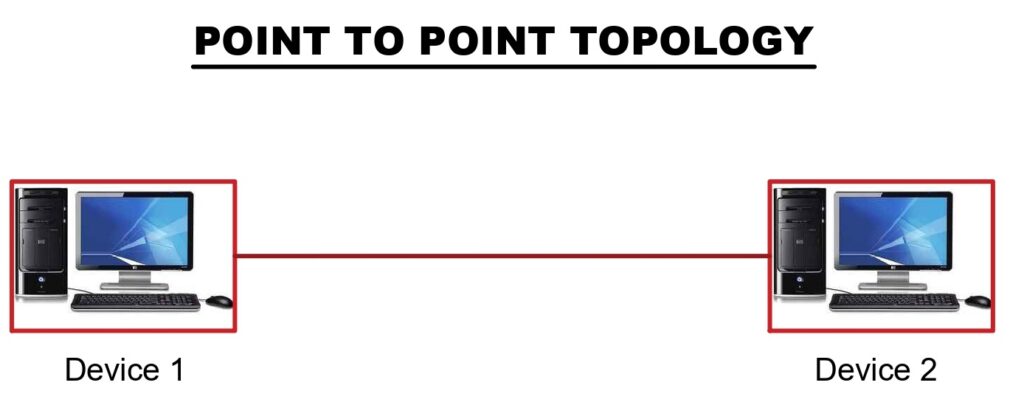
Bus Topology
A bus topology is designed such that all the stations are connected via a single cable, which is known as the backbone cable. A device/node in the bus topology can be connected in two ways; either the device would be connected to the backbone cable via a drop cable or directly to the backbone cable.
The backbone cable is a bi-directional cable. The backbone cable has terminators at both ends. A coaxial or twisted pair cable is used that supports up to 10 Mbps. The bus topology has a multi-point connection.
The devices in a bus topology follow several MAC (Media Access Control) protocols. In a bus topology, if a node wants to send a message over a network, a message is sent over the network.
All stations in the network would receive it, whether it was addressed or not. 802.3 (Ethernet) and 802.4 are examples of bus topology networks. For bus topology, the most common access method is CSMA (Carrier Sense Multiple Access).
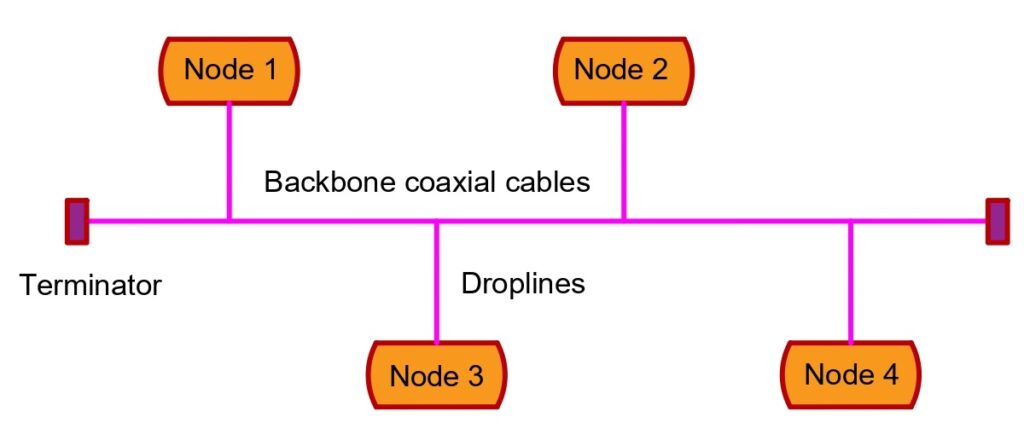
CSMA CD: The Carrier Sense Multiple Access Collision Detection, often abbreviated as CSMA CD is an access method that is used for detecting collision. After the detection of a collision, the sender will stop transmitting data. Thus, CSMA CD works on the idea of “recovery after a collision”.
CSMA CA: The Carrier Sense Multiple Access Collision Avoidance, often abbreviated as CSMA CA is an access method that is used to avoid collisions by checking if the media is busy or not. When the transmission media is busy, the sender will wait until the media becomes idle. CSMA CA effectively reduces the possibility of collision.
Advantages
- The bus topology has a low installation cost because the cables are directly connected without passing through a hub.
- The bus topology operates at a moderate data speed of up to 10 Mbps.
- The bus topology is well known due to easy installation and troubleshooting techniques.
- In the bus topology, if one node faces failure, there will be no effect on the other nodes.
Disadvantages
- The bus topology needs a lot of cabling.
- The bus topology requires specialized test equipment for detecting cable faults.
- In the bus topology, if there is a fault in the backbone cable, the communication of all the nodes will be disrupted.
- In bus topology, if two nodes send data simultaneously, both signals may collide with each other.
- In the bus topology, repeaters are used for regenerating the signal.
Examples
Ethernet LAN is the most common example of the bus topology. In this case, the devices are connected by a coaxial cable or a twisted pair cable.
Ring Topology
The ring topology has a similar arrangement as the bus topology, but here both ends are connected to devices. Thus, a ring is formed by connecting devices. Each device is connected to exactly two neighboring devices.
As the name suggests, all the nodes are connected in a closed-loop configuration. In the ring topology, a node that receives a signal from the previous device will retransmit it to the next node.
In the ring topology, the flow of data is in one direction only, that is, it has unidirectional flow. The ring topology can also be made bidirectional by having two connections between each network node.
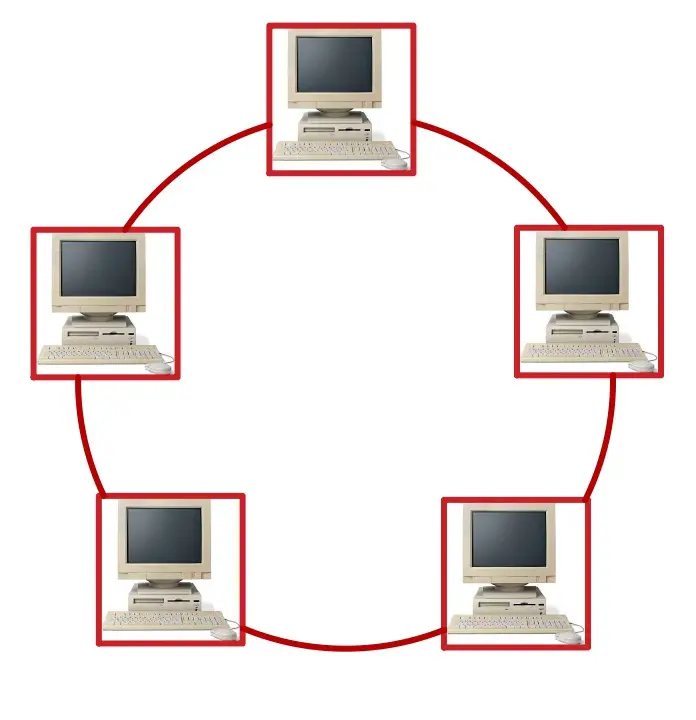
Such a type of network topology is called Dual Ring Topology. In the ring topology, data flows continuously in a single loop. It is known as an endless loop. In the ring topology, there are no terminated ends. Hence, each node is connected to other nodes, having no termination point.
In the ring topology, the data flows in a clockwise direction. In the ring topology, the most commonly used access method is the token passing method.
Token Passing Method:
A token is defined as the frame that circulates within the network. Token passing is defined as the network access method by which a token is passed from one node to another.
Working
Among all the stations connected in the ring topology, one station is a monitor station. The monitor station will take responsibility for performing the operations. When a station wants to transmit data, it will hold the token. After it completes the transmission, the token is released.
When no station is transmitting, the token keeps circulating within the ring. The two types of token release rings are- Early token release (token is released just after transmitting data) and Delayed token release (token is released after getting acknowledgment from the receiver).
Advantages
- In the ring topology, the data transmission is at high speed.
- The chances of collision are minimal.
- Ring topology is cheap to install and expand.
- Ring topology is comparatively cheaper than a star topology.
Disadvantages
- If one node fails, the entire network will fail.
- In the ring topology, troubleshooting is difficult.
- In a ring topology, the addition or removal of stations would disrupt the entire topology.
- Ring topology is less secure.
- Communication delay is seen in a ring topology. When the number of devices in the network increases, the communication delay will also increase.
Example
In a computer lab, when some computers are connected in a ring. These computers can transmit data within themselves.
Star Topology
In star topology, each node is connected to the central hub, switch, or central computer. The central computer is also called a server and the devices connected to it are called clients.
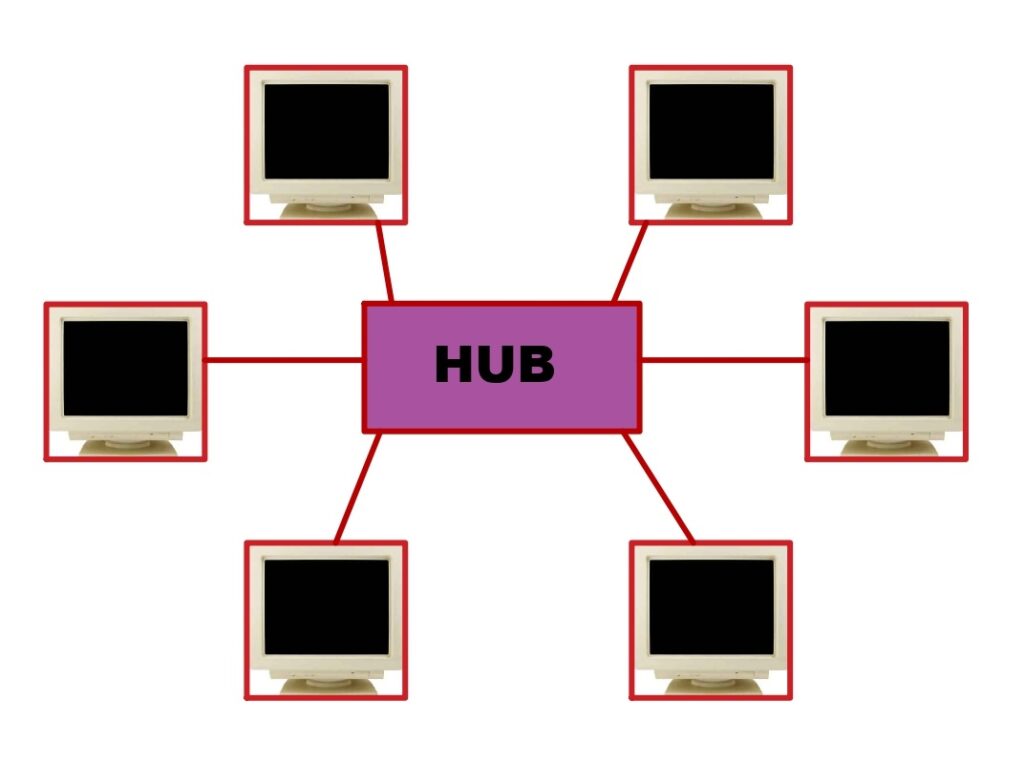
For connecting clients to the server, coaxial cables are used. In the star topology, hubs and switches are used. Star topology is the most widely used topology of all. The protocols used in a star topology are CSMA (Carrier Sense Multiple Access).
Advantages of Star Topology
- Troubleshooting is easier even when compared to bus topology. In star topology, each device is connected to the server via a different cable, so when a device is faulty, its cable only needs to be checked.
- Complex network control features can also be implemented.
- If a device fails, the entire system does not fail. So, the star topology is robust.
Disadvantages of Star Topology
- If the hub fails, the entire system fails.
- Installation cost is high.
- The performance of the system is based entirely on a hub.
Example
The LAN (Local Area Network) in an office where all computers are connected to a central hub is an example of the star topology. The star topology can also be implemented in a wireless network
Mesh Network Topology
The mesh topology has a network arrangement in such a way that devices are connected to each other by particular channels. The dedicated channels by which each device is connected to others are known as links.
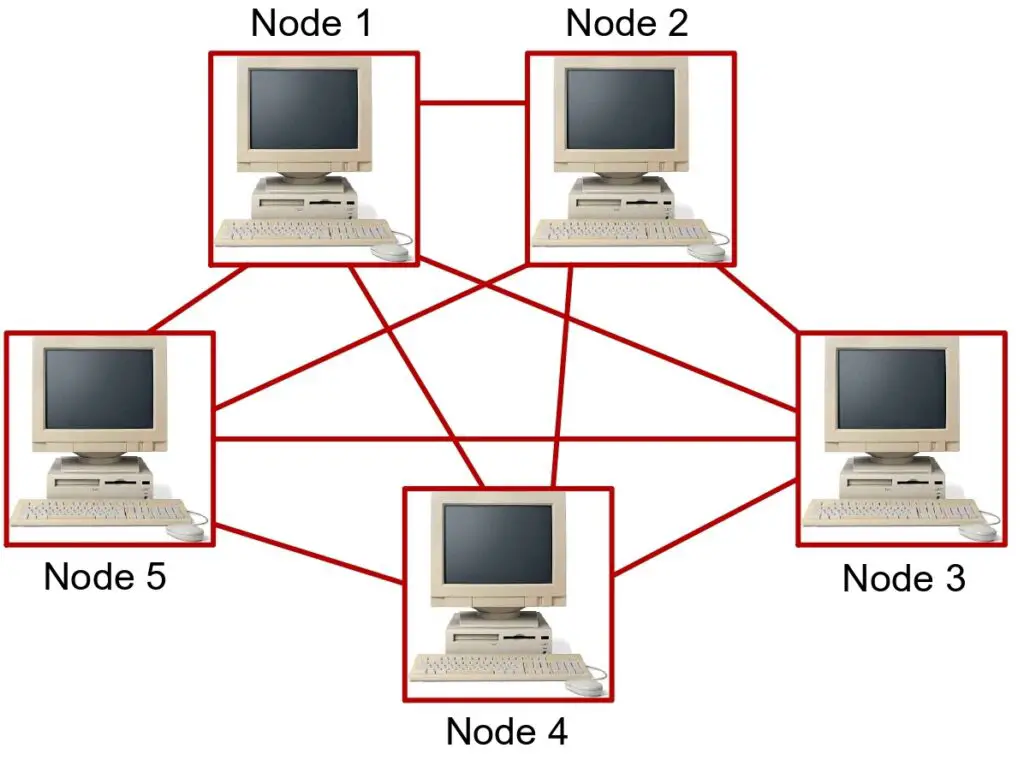
In a mesh topology, there is no switch, hub, or any other central device. Mesh topology finds application in WAN implementations. In a WAN, communication failure can be a critical factor of concern. In mesh topology, the number of ports required can be calculated by :

N is the Number of devices connected to each other in a mesh topology.
In a mesh topology, the total number of dedicated links required to connect the devices is given by:

N is the Number of devices connected to each other in a mesh topology.
- For example, there are 6 devices to be connected in a mesh topology. So, the number of ports needed will be 6 (6-1) = 30. Each device would need an N-1 number of ports. Hence, in the example taken above, each device needs 5 ports.
- The total number of dedicated links required is 6*5/2 = 15.
Types of Mesh Network Topology
Mesh topology is of two types:
- Full Mesh Topology: In a full mesh topology, each device would be connected to the rest of the devices available in the network.
- Partial Mesh Topology: In a partial mesh topology, rather than all devices being connected, only some devices are connected to the devices with whom they communicate frequently.
Advantages
- Mesh topology is very reliable because if any link breaks down, communication between other connected devices is not affected.
- In a mesh topology, communication is very fast.
- Mesh topology provides good security and privacy.
- It is easy to add new devices to the mesh network.
Disadvantages
- Mesh topology has a high maintenance cost.
- Due to bulk wiring, the cost of wiring is also high.
- Mesh topology is suitable for less number of devices only.
- The redundant connections result in lower efficiency of the network.
Example
Internet backbone is the most common example of the mesh topology. In the internet backbone, various internet providers are connected to each other by dedicated channels. Other examples are military communication systems, aircraft navigation systems, etc.
Tree Network Topology
The tree topology has a combination of bus and star topologies. All the devices are connected to each other in a hierarchical manner. In tree topology, the topmost node is called the root node.
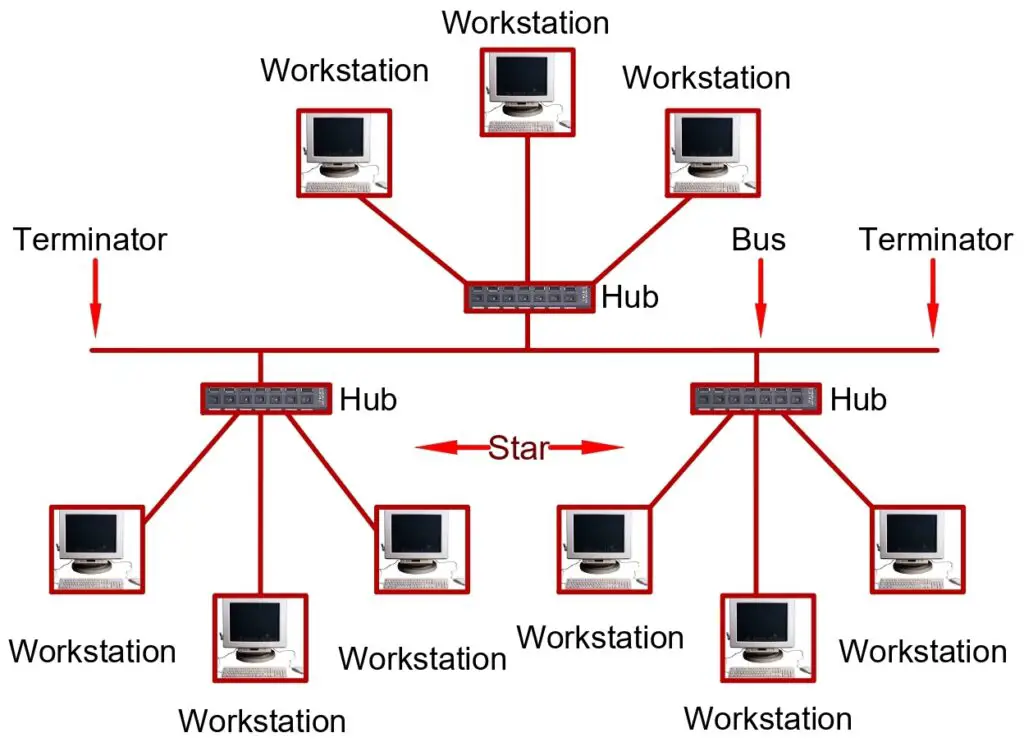
All other nodes are the descendants of the root node. Parent-child hierarchy is seen because, in tree topology only one path exists between two nodes.
Advantages of Tree Network Topology
- A new device can be easily added to the existing network.
- It is easy to detect and correct errors.
- If one device breaks down, the other devices are not affected.
Disadvantages
- Troubleshooting is difficult.
- When new devices are added, reconfiguration becomes difficult.
Example
broadband transmission – signals can be sent at long distances without attenuation.
Hybrid Network Topology
A combination of different topologies is called a hybrid topology.
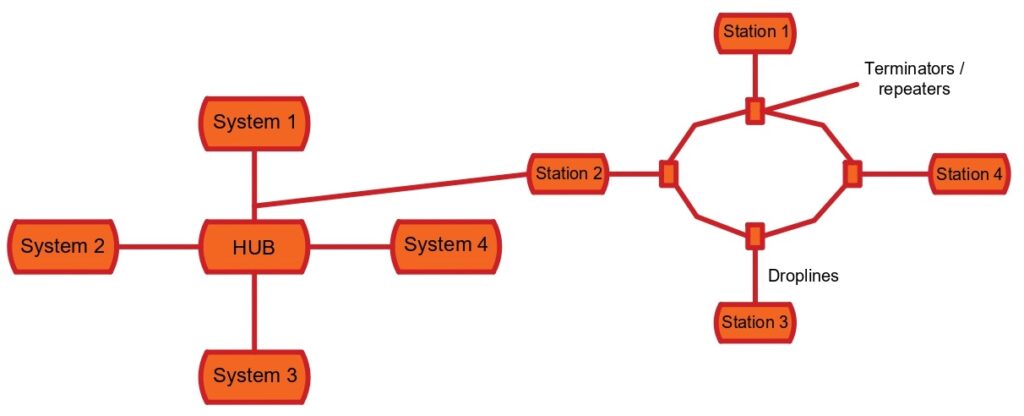
Advantages
- If one device breaks down, the other devices are not affected.
- Hybrid topology is very flexible because it can be designed according to the requirements of the organization.
Disadvantages
- The design is very complex.
- The hub used in hybrid topology is expensive.
- Installation and maintenance costs are high.
Example
Say Network-1 has a bus topology and Network-2 has a star topology. If both of these topologies are connected, the resultant topology is called a hybrid topology.
Logical Network Topology
Logical topology does not explain the physical wiring of a network. A logical topology would rather describe the flow of data and information from one system to another and the route that it takes during the flow. Some examples are:
- Logical Star Topology: The logical star topology makes use of the logical bus topology for transferring data among devices.
- Logical Ring Topology: In the logical ring topology only one node is allowed to transfer data in a network at a time. A token system is used to ensure that only one device is transmitting at a time.